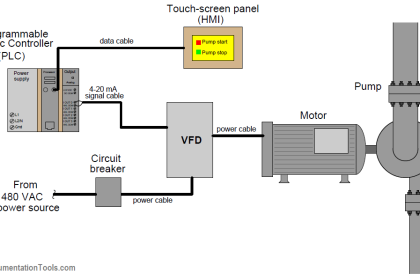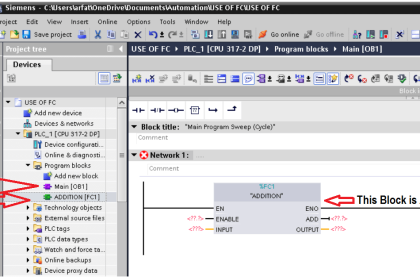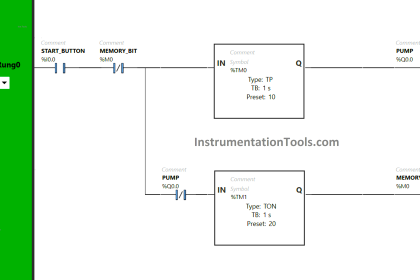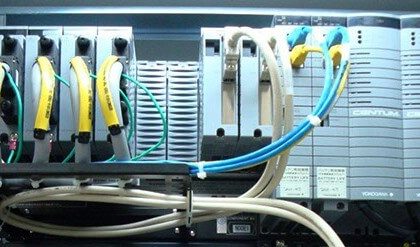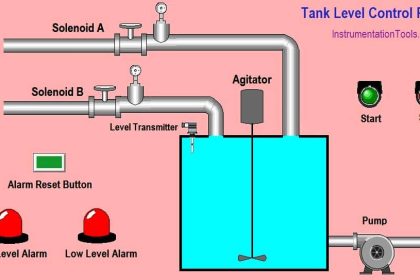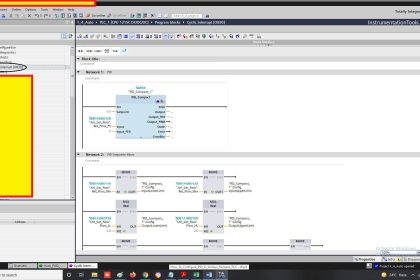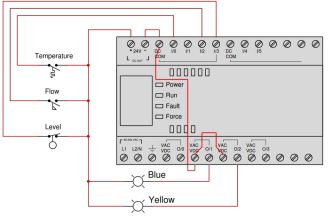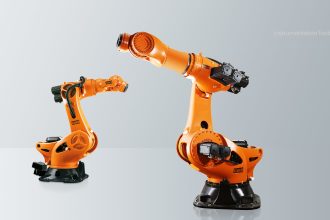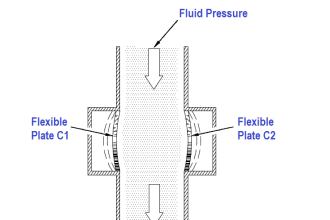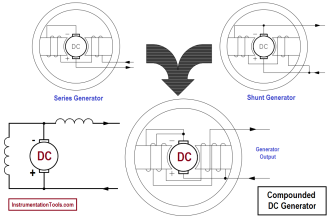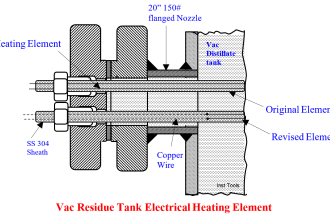Power supplies are a critical component of any industrial automation system. Control circuits need a stable and reliable power source to operate properly, and any disruptions or fluctuations in power can lead to control circuit components failing, which can lead to a series of troubles in your process.
In this article, we will discuss the importance of power supplies for our automation system and how to select the power supply that best fits your application.
Contents:
- What is a power supply?
- Importance of power supplies in PLC and automation systems.
- How to select a power supply?
- TIA Portal selection tool.
- Conclusions
What is a Power Supply?
A power supply unit is a device that converts electrical power from one form to another in order to provide power to a load. In an automation control circuit, a power supply is used to convert the incoming AC voltage into a DC voltage that is suitable for powering the electronic components of the circuit, such as sensors, controllers, and actuators.
The power supply must be designed to provide a stable and reliable DC voltage that meets the requirements of the components in the circuit.
Power supplies for control circuits may have various features such as voltage regulation, overload protection, short circuit protection, and noise suppression to ensure that the components in the circuit receive a clean and steady power supply.
Importance of Power Supply in PLC Automation Systems
Power supplies are a critical component of PLC (Programmable Logic Controller) and automation systems. These systems need a stable and reliable power source to operate properly, and any disruptions or fluctuations in power can cause serious problems, including:
Downtime:
If the power supply to a PLC fails, the system will typically shut down. This can result in significant downtime, lost productivity, and even damage to equipment or products.
Data loss:
If the power supply fails while data is being written to memory or storage, the data can be lost or corrupted. This can cause serious problems, especially in critical applications such as process control or safety systems.
Component damage:
Voltage spikes or other power fluctuations can damage sensitive electronic components within the system, such as microprocessors, memory chips, or I/O modules. This can lead to expensive repairs or replacement costs.
Safety risks:
In some applications, such as safety-critical systems or hazardous environments, a power failure or other disruption can create serious safety risks for personnel and equipment.
Therefore, a reliable and high-quality power supply is essential to ensure the proper and safe operation of PLC systems.
In addition, many PLC and automation systems have specific power supply requirements, such as voltage range, current capacity, and certifications that must be met to ensure proper operation and compliance with safety standards.
Power Supply Sizing for Industrial Automation Systems

To select a power supply that fits your system, you will need to consider several factors, including:
Input Voltage:
Determine the input voltage range required by your system. This can vary depending on the specific system components and requirements.
Output Voltage and Current:
Determine the output voltage and current requirements of your system. This will depend on the type and number of components being powered, as well as the current draw of each component. Be sure to choose a power supply that can provide sufficient voltage and current for your system.
Efficiency:
Consider the efficiency of the power supply. Higher-efficiency power supplies will waste less energy and generate less heat.
Safety and Compliance:
Check the power supply for relevant certifications, such as CE or UL, to ensure it meets your requirements.
Environment:
Consider the environment in which the system will be installed. If the system will be installed in a harsh or dusty environment, you may need a power supply with protection against environmental factors.
Mounting:
Consider how the power supply will be mounted and secured within the system.
Budget:
Consider the budget available for the power supply. Different power supplies come with different features and prices, so it’s important to find a balance between quality, performance, and cost.
Consider redundancy:
For critical systems, it’s a good idea to consider a redundant power supply setup. This involves using two power supplies in parallel so that if one power supply fails, the other can take over. This can help minimize downtime and prevent damage to equipment.
Select a power supply with sufficient headroom:
When selecting a power supply, it’s important to choose one that has some extra capacity than what is required by your system. This will help ensure that the power supply can handle any temporary spikes in power demand that may occur.
Check for noise and ripple:
When selecting a power supply, be sure to check the specifications for noise and ripple. These are unwanted fluctuations in voltage or current that can cause interference with other components in your system. Look for a power supply with low noise and ripple specifications to minimize the risk of interference.
Considering these factors will help you choose a power supply that meets the specific requirements of your system and ensures reliable and safe operation.
SIEMENS TIA Portal Selection Tool
Many automation vendors provide selection tools to help you select a power supply that is suitable for your control system. These tools can simplify the selection process and ensure that you choose a power supply that meets your requirements.
Some vendors will provide online configurators that allow you to input your specifications and requirements, such as the input & output voltages, current, and power requirements of your system. The configurator will then recommend a power supply that meets your needs.
Other vendors may offer software that allows you to input your specifications and generates a list of compatible power supplies. This software may also provide additional information, such as product specifications, installation instructions, and technical data sheets.
A very good example of this is the TIA Portal Selection Tool which we will explain how to use it to select a power supply.
There are an online version and downloadable software from the TIA Portal selection tool; we will show how to use the software to select a power supply. See picture 1.

The first thing you need to do after downloading and installing the tool is to use the New Device option to add the components of your control circuit.
As you see in the previous picture, we have 3 controllers and an HMI panel in this project. And we need to select a power supply that fits them. See picture 2.

Next, go to the 24 VDC consumer view page to start adding power supplies. The first thing that you will notice is the red square at the bottom of each component.
The red square indicates that there is no selected power supply for this device. You notice also that some devices have two red squares, that is because they need two sources of power one for the internal consumption of the device and the other one for the load consumption.
Press New power supply and add a power supply. See picture 3.
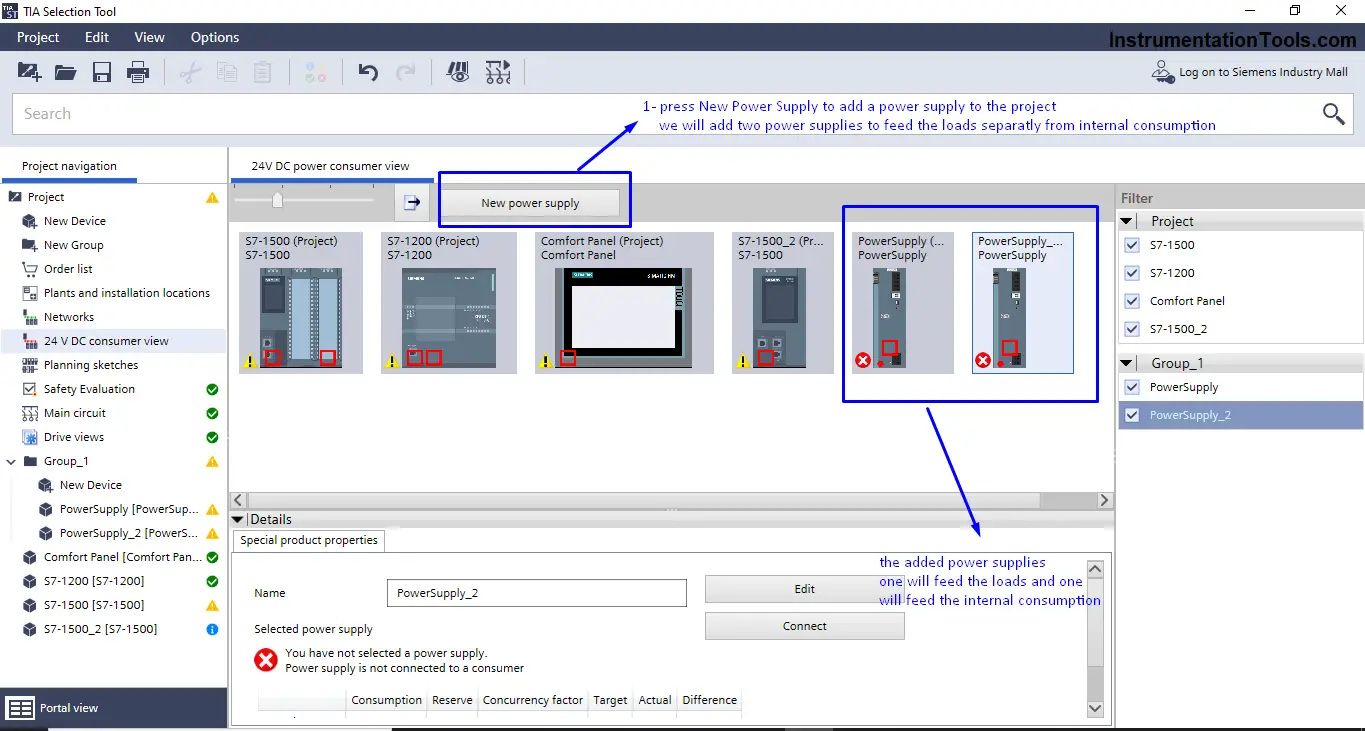
We added two power supplies because we want to separate between power for internal consumption and power for the loads.
Now select a power supply and draw a connection to desired devices. See picture 4.
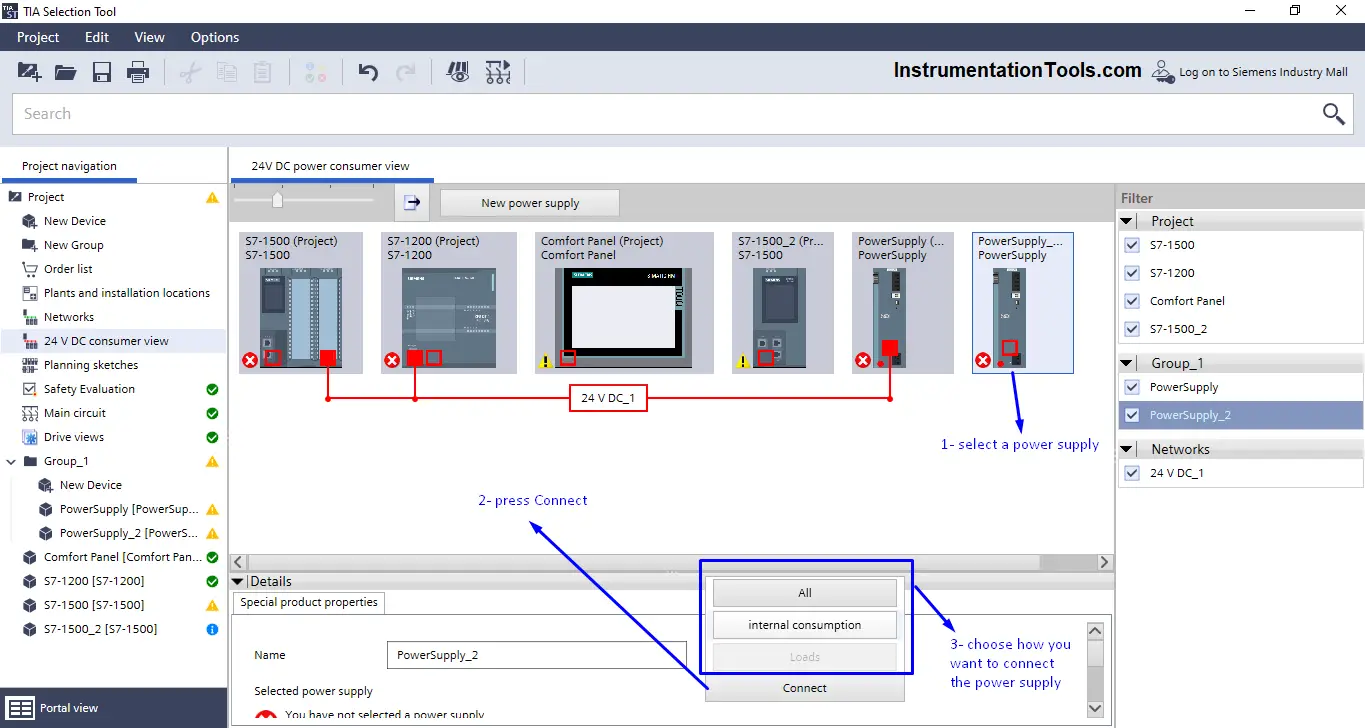
You have to make sure to connect all devices (internal and load consumption) in your project, after that select a power supply, and choose the Edit option to configure your power supply.
Keep in mind that up till now the power supply you have chosen is a generic power supply, you still have to select other options so the software can help you choose the best model for your system. See picture 5.
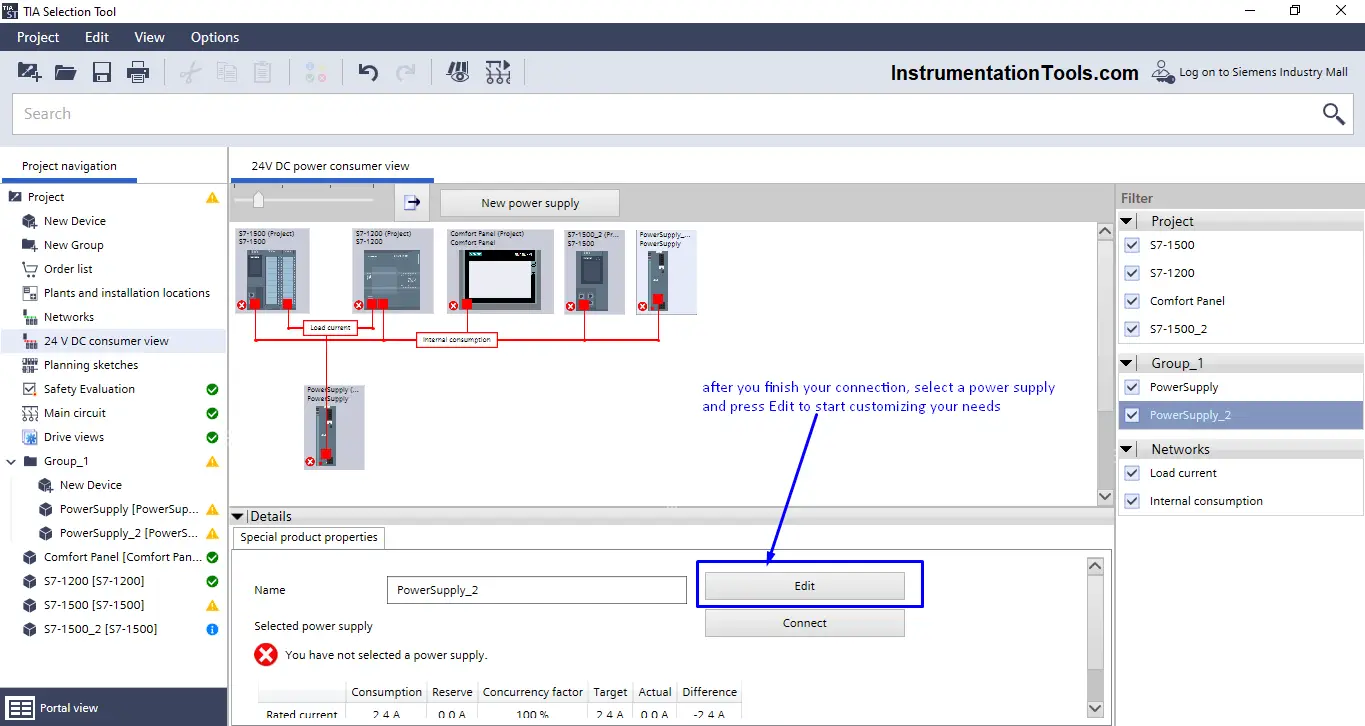
Pressing the Edit button will take you to the Manage Power Supply page, press add power supply to start customizing your needs. See picture 6.
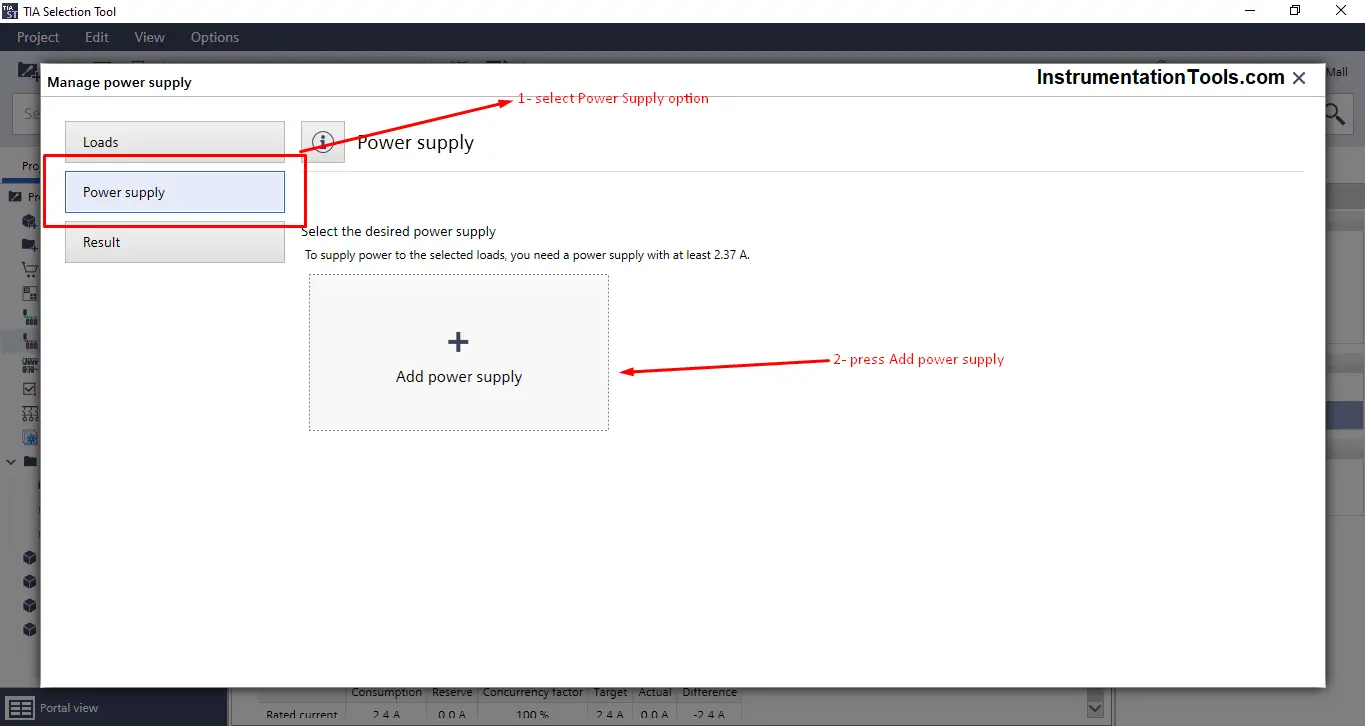
After that, you will need to assign different specifications that fit your requirements.
As you select different options the software will filter out the models that don’t fit your choices. See picture 7.
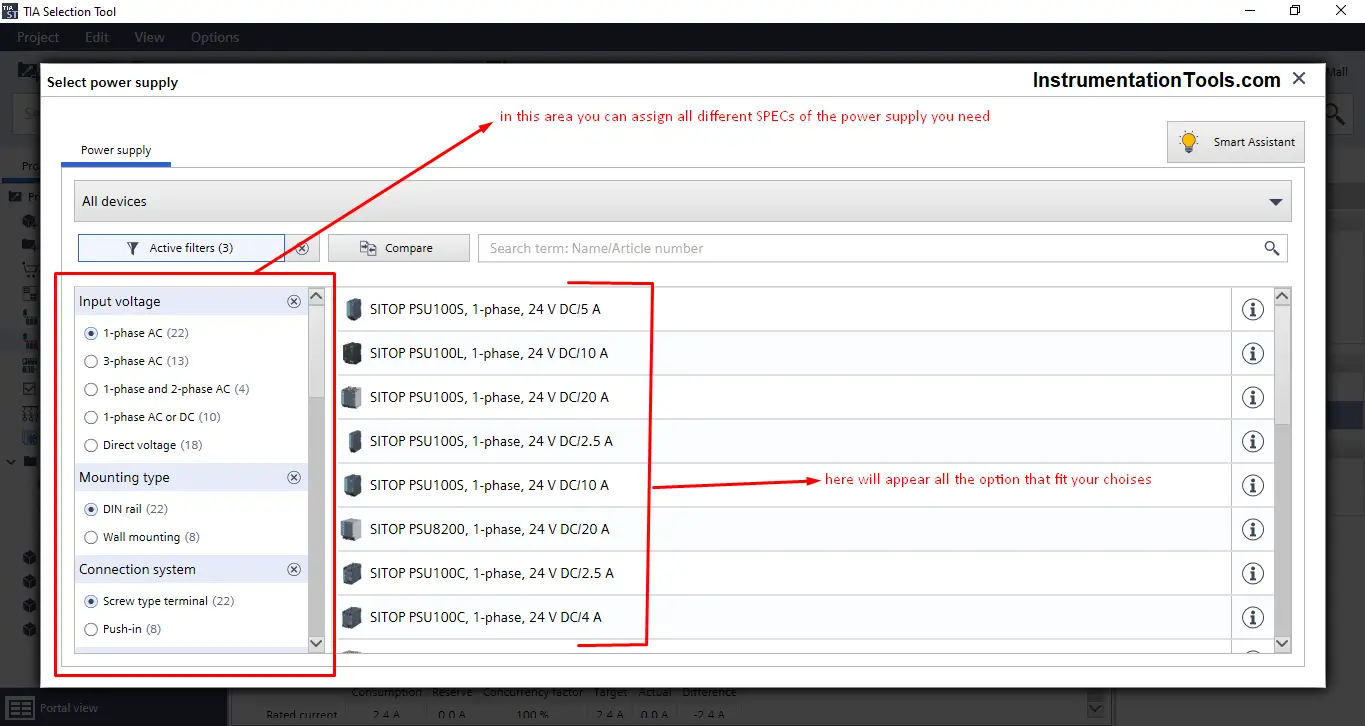
As you see in the previous picture, the software will provide you with all the available power supplies that fit your requirements.
Select the power supply that you want and press apply selection. See picture 8.
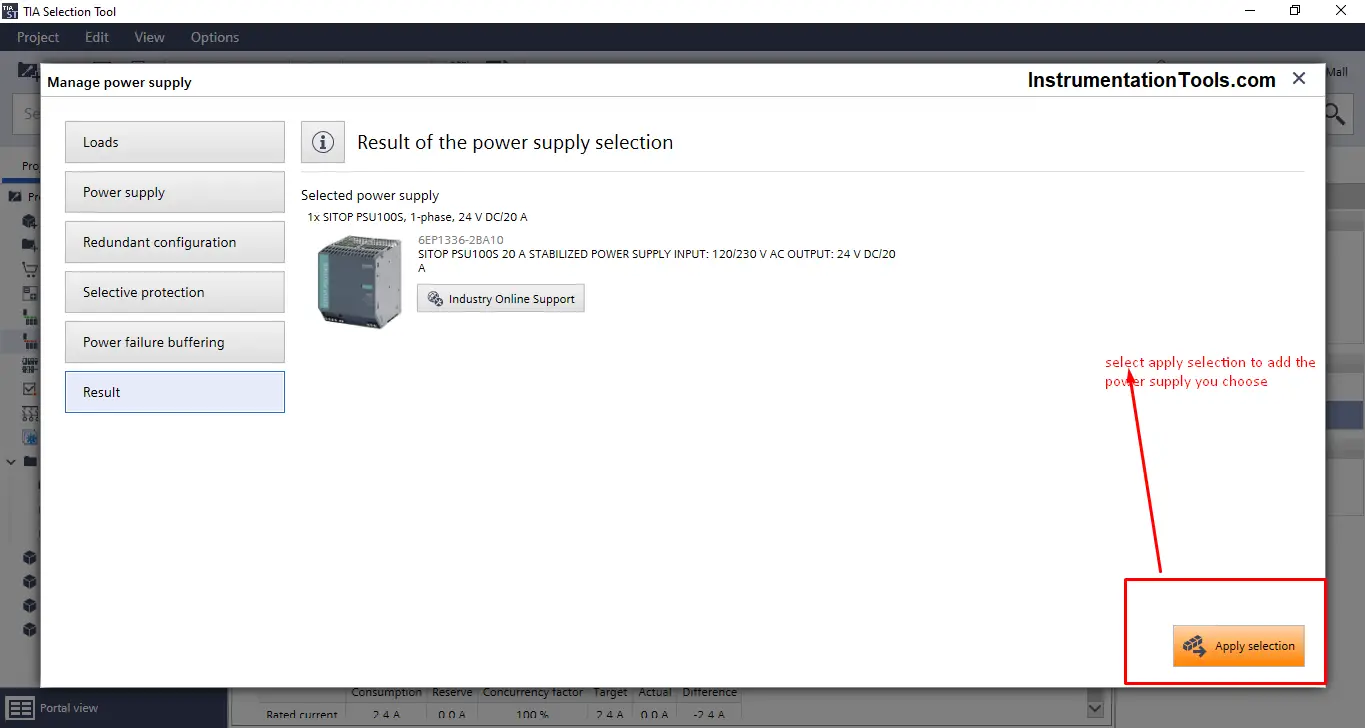
Now, you have added a power supply; do the same previous steps to add the second power supply. See picture 9.
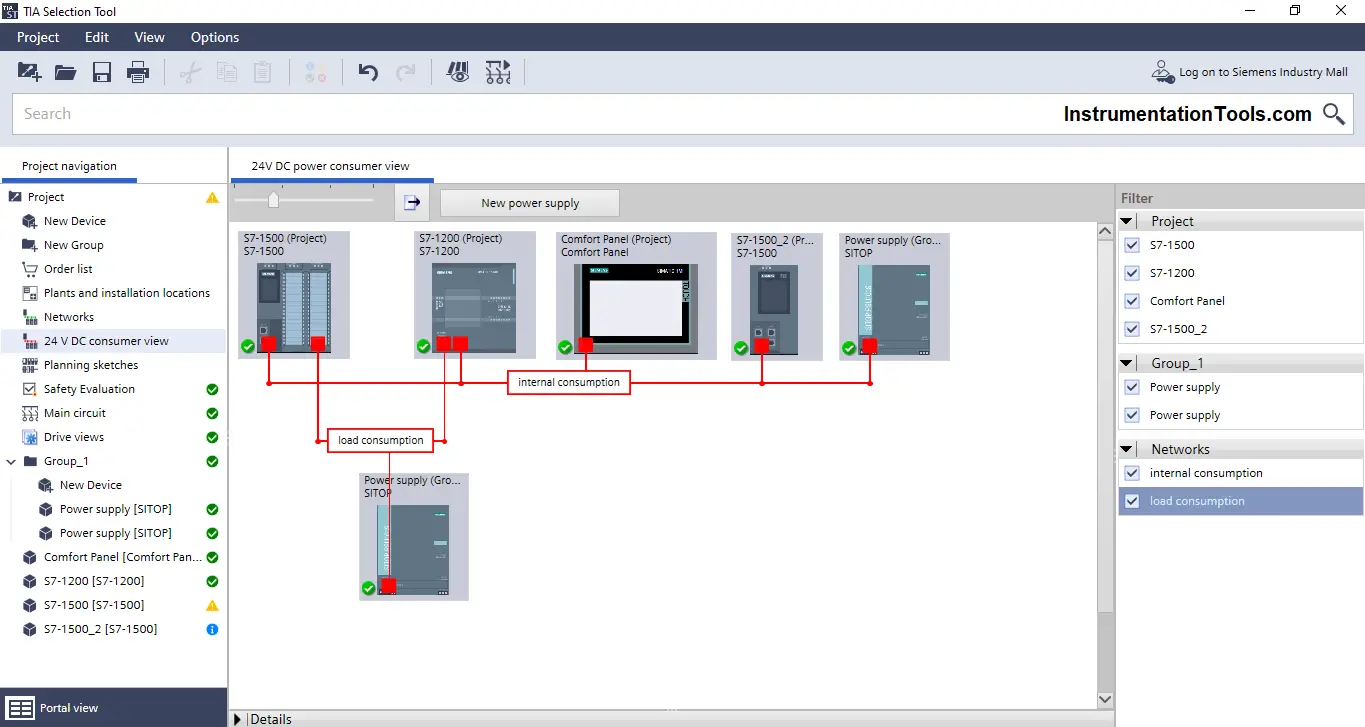
Now that you have selected the power supplies the red squares disappeared and a green check mark is now shown to indicate that the system is valid.
Conclusion
- Power supplies are devices used to provide power to your control circuit components such as PLCs, sensors, and actuators.
- A proper selection should be made for the power supply to ensure the proper and safe operation of your control system.
- Many factors should be considered when selecting a power supply, such as efficiency, environment, mounting, and cost to help make suitable decisions.
- Many vendors will provide tools to help select your control components, such as the TIA Portal selection tool.
If you liked this article, then please subscribe to our YouTube Channel for Instrumentation, Electrical, PLC, and SCADA video tutorials.
You can also follow us on Facebook and Twitter to receive daily updates.
Read Next:
- Induction Motor using PLC Logic
- Offline and Online UPS Systems
- Modbus Driver for SCADA System
- Comparison of PNP and NPN Sensors
- Allen Bradley ControlLogix Architecture

